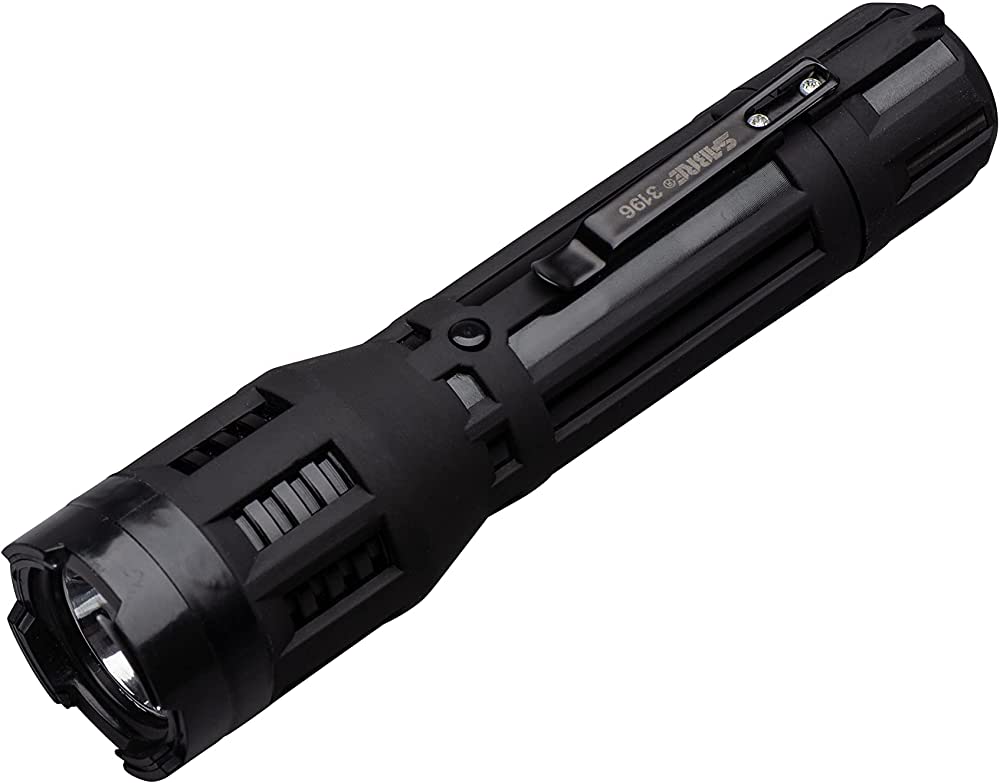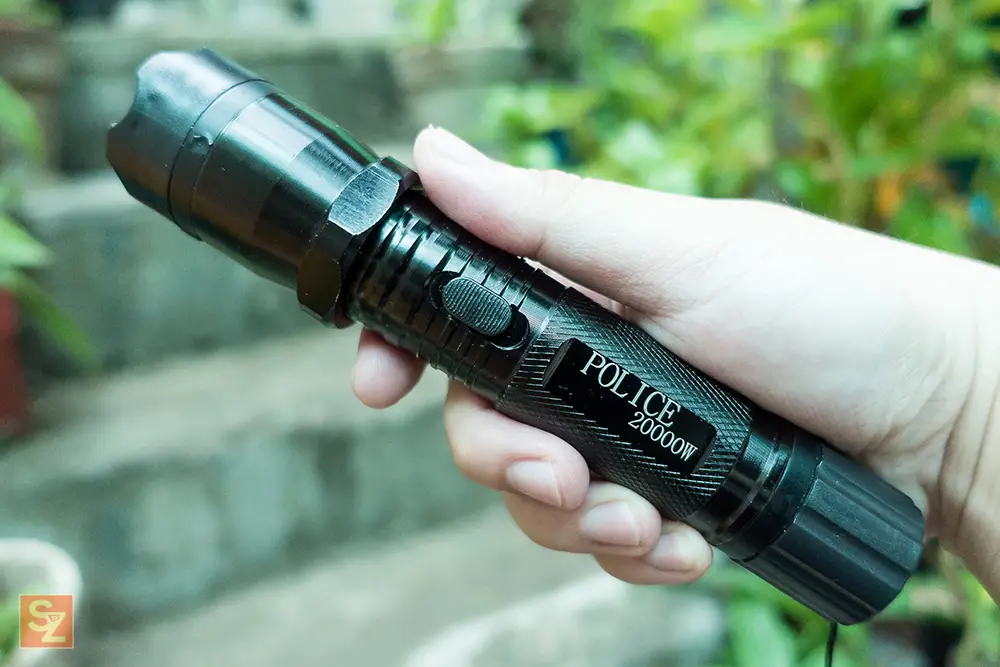Are you considering getting a stun gun flashlight? You must be aware of the pros and cons of this weapon, as well as the safety considerations that go into using it.
This guide will provide you with a comprehensive overview of all aspects of using a stun gun flashlight.
Stun guns, also known as voltage weapons, electric shock devices, and non-lethal self-defense tools, are weapons with two or more electrodes that deliver an electric shock to disable an assailant. When the electrodes contact the assailant’s body the electrical current causes involuntary muscle contractions, temporarily disabling them and giving you time to flee. The electric current of a stun gun is far lower than that of a standard household socket and stun guns are designed to reduce serious injury or death.
Although they offer protection against threats such as animal attacks and robbery attempts at close range, stun guns also come with their own set of risks. In this guide we will discuss the pros and cons of using a stun gun flashlight along with safety considerations that should be kept in mind before investing in one. We will go over how to use a stun gun so that you can make sure to use it effectively and responsibly when the time comes. We will also discuss what types are available on the market today so that you can choose one according to your needs.

Definition of stun gun flashlight
A stun gun flashlight is a self-defense device that combines a powerful flashlight with an electric shock weapon. When an attacker strikes someone, the flashlight delivers an electrical shock to the assailant, rendering them momentarily unable to fight or use weapons. The electricity can disrupt the nerve functions of the attacker and cause enough pain for them to cease their attack.
Stun gun flashlights vary in power from five million volts up to twenty million volts and are typically powered by its own internal battery source or by conventional AAA batteries. They come in both handheld and pocket models and are often equipped with bright LED bulbs for optimum illumination of the target. Some models even feature additional features such as alarms, strobes, and strobe lights to further deter assailants. In addition, some stun gun flashlights utilize rubber electrodes on one end of the device that deliver an extra-strong electric shock when applied against an assailant’s skin.
Importance of understanding its pros, cons, and safety considerations

When considering the purchase of a stun gun flashlight, it is critically important to understand not only its features and capabilities, but also its pros, cons, and safety considerations. This guide offers an easy-to-follow approach that provides the necessary information to ensure you make an informed decision that fulfills your personal safety goals.
A stun gun flashlight contains a powerful electrical charge designed to disable an attacker. Its primary benefit lies in its nonlethal function as well as its ability to provide illumination. That said, proper use is key for ensuring the best outcome possible in any given scenario.
Pros:
· Nonlethal: Highly effective in allowing for self-defense without causing permanent physical injury
· Discreet: Easily concealed and provides momentary disabling power without alerting nearby people or drawing attention
· Bright light source: Easy to spot a perpetrator from an especially safe distance
Cons:
· Limited range: Not suitable for long distances
· Lack of ammo: Cannot be used as projectile weapon
· Limited voltage: Some models will not reach human skin’s threshold voltage level
Safety Considerations:
· Familiarize yourself with local self-defense laws prior to purchase if you’re considering carrying
Brief overview of the guide

This guide outlines the pros and cons of purchasing a stun gun flashlight, as well as the relevant safety considerations. A stun gun flashlight is a device that combines a powerful flashlight with an electric shock weapon. When used, it has the potential to incapacitate an attacker with an electrical charge. Additionally, since it also functions as a high-powered light source, it can be used to illuminate dark areas and remove safety threats in potentially dangerous situations.
In this guide we will explore the features of various stun gun flashlights, discuss their advantages and disadvantages, examine how they are best used in a variety of contexts, and provide essential information about their legal status in different jurisdictions. Through this examination of the key considerations relevant to these devices, readers will have all the information they need to make informed decisions about purchasing and responsibly using stun gun flashlights for personal protection.
Pros of stun gun flashlight
One of the major pros of a stun gun flashlight is that it is an effective form of self-defense. Stun guns have been proven to be extremely effective in incapacitating attackers, which gives individuals plenty of time to get away and seek help.
Another pro is that stun gun flashlights are straightforward and easy to learn how to use. Many models come with detailed instructions for use and safety, making them perfect for those who are wary about using a potentially dangerous defense mechanism but still want something that can provide effective protection.
Stun gun flashlights also have the benefit of combining two useful items into one easy-to-carry device; in addition to providing an option for self-defense, the device can also be used for general illumination purposes like finding your way around a dark room or searching out objects in areas with limited lighting. A built-in LED light may also be helpful when shining it on an attacker from a distance as a warning before resorting to using the stun gun function.
Ability to incapacitate an attacker
Electric stun guns are designed to temporarily incapacitate attackers with high-voltage electricity. When brought in contact with the attacker, the current causes pain and muscle contractions that disrupt the person’s voluntary motor functions and give you time to escape.
Most stun guns operate on 9-volt batteries, though some more powerful models require more voltage. Higher voltage means a longer duration of shock that will cause greater muscle contractions, which is important when dealing with multiple assailants or a more aggressive attacker. They also come in both direct contact and non-contact varieties so you can choose a model depending on your needs.
Ideally, it is best to always be prepared for emergencies, so having a reliable self-defense weapon like a stun gun is essential for providing personal protection against potential attackers. However, it is important to remember that while they are effective at temporarily incapacitating an assailant when used correctly, they can also inflict severe injury if not used appropriately. Therefore it is important to follow safety guidelines such as keeping the device out of reach of children and making sure you read all accompanying instructions thoroughly before using it.
Non-lethal self-defense option

Stun guns and flashlight are an ideal non-lethal self-defense option, particularly for those who don’t have a familiarity with weapons. They offer an excellent, non-confrontational alternative to the greater seriousness of a firearm. But it’s important to consider the pros and cons of owning and carrying one before you make a purchase.
Typically small in size, they come in various designs. Most models are rechargeable, so battery life is not an issue like it would be with a traditional flashlight. Shock strength varies from model to model and usually ranges from as low as 50KV to as high as 2 million volts (MV).
Pros: Stun guns and flashlights provide an intimidating deterrence with their bright light probes and even brighter electric arcs (built into select models). This can often be enough to ward off aggression without having to shock a perpetrator. While stunning someone isn’t something most people want to do, they offer security and peace of mind while providing less lethal force than firearms or other more dangerous weapons in scenarios where deadly force isn’t needed or justified.
Cons: Stun gun use can cause tissue damage or nerve disruption on the point of impact which could potentially limit mobility depending on the severity of the shock received by the attacker or criminal suspect. Furthermore, stun guns cannot be used against multiple attackers nor do they guarantee anonymity for the user during a crime – many states require that owners register with law enforcement officials if found in possession of such devices.
Safety Considerations: The legalities surrounding stun gun possession vary from state to state – some outright banning them entirely while others demand that users obtain permits prior to ownership or carry registration cards when demonstrating devices on public property. It is important that you inform yourself on all local laws concerning carrying stun guns before utilizing them either for personal defense or demonstration purposes so as not to run afoul of any statutes which may incur fine or worse still imprisonment in extreme cases.
Doubles as a flashlight
A major benefit of owning a stun gun flashlight is that, in addition to its self-defense capability, it doubles as an ordinary flashlight. An LED lightbulb makes it possible to use the same device as an ordinary flashlight. Many models are even equipped with additional features such as a zoom control and variable brightness modes. This makes these devices extremely versatile for dealing with tough situations, such as in remote outdoor activities or walking late at night.
This dual functionality can be an invaluable asset if you find yourself in a situation where you need both convenience and defense capabilities.
Cons of stun gun flashlight
In spite of the advantages of using a stun gun flashlight, there are some potential drawbacks that must be considered before acquiring one. The following are a few of the most important cons to be aware of regarding this type of self-defense device:
- Lack of accuracy: Because the electrical current emitted by a stun gun flashlight can disperse during contact, it can potentially hit unintended targets or not shock an attacker effectively.
- Limited effectiveness: Stuns guns are only reliable against attackers that are close enough to make direct contact with them. The current will also become weaker over distance and may not be as effective if used on an attacker at further distances.
- Possible legal repercussions: Depending on where you reside, possession and/or use of a stun gun may be illegal and could lead to criminal charges if it is deployed in certain circumstances. It is important to familiarize yourself with local laws prior to acquiring one.
Possibility of causing harm or injury
When it comes to purchasing a stun gun flashlight — or any type of stun gun — one of the most important considerations is the potential for causing harm or injury. It is important to be aware of the risks involved in using and owning this type of device, and take steps to ensure that it is used safely.
Stun guns, when used correctly, are not known to cause permanent injury or death. The primary purpose of a stun gun is to cause an assailant temporary paralysis, allowing time for the user to escape from the situation. As such, care should be taken when choosing a model, as some higher-powered models may have unintended consequences if misused.
As with any other device containing electricity or electricity-producing chemicals, there is always a risk of fire or electric shock. To reduce this risk and ensure safety during use, buyers should consider only reliable brands and ensure users are properly trained in how to use their device safely and responsibly before operating it. And though tendrils produced by a stun gun have not been proven to carry more than short-term effects on those receiving shocks, users should familiarize themselves with their state and local laws regarding owning such devices as restrictions vary significantly by locale.
Limited range and effectiveness compared to other self-defense options
Stun gun flashlights are popular self-defense weapons that offer convenience and versatility. However, like any self-defense tool, they have both pros and cons that should be taken into account.
One of the main limitations of stun gun flashlights is their limited range and effectiveness compared to other self-defense options such as pepper spray or a baton. Because they rely on electric current rather than projectile force to incapacitate an attacker, the effective distance between the user and attacker needs to be quite short — typically less than 15 feet — for them to work. This can put the user at an increased risk for personal injury if their attacker is armed with an edged weapon or is within striking range.
Additionally, unless multiple areas of the body are exposed for electrocution simultaneously, users may find that their stun gun flashlight does not effectively incapacitate their assailant due to reduced electric shock delivered from one area alone. Proper training with a stun gun flashlight weapon should include practicing in diminished light circumstances that may arise in an attack situation so users can better understand how effective the device can be at ranges of up to 15 feet or less. Appropriate care must be taken when deploying this device in order to better ensure its safety and effectiveness in a potential crisis situation.
Conclusion
In conclusion, the pros and cons of stun gun flashlights should be carefully weighed before making a purchase. It is important to understand how these devices work, the potential risks involved with their use, and what safety precautions should be taken.
A stun gun flashlight can act as a powerful tool of self-defense, but it is also important to properly educate yourself on what they are capable of and responsible use must be prioritized at all times. Becoming aware of the facts is key in ensuring that you are able to make the right decision for your circumstances and be properly equipped if you ever find yourself in a situation where you may feel unsafe or threatened.
FAQs
What is the disadvantage of a stun gun?
One of the main disadvantages of stun guns is that they require close proximity to the target in order to be effective.
Are stun guns safe to use?
When used properly, stun guns can be a safe and effective means of self-defense.
Are flashlight stun guns any good?
Flashlight stun guns can be a good option for self-defense because they combine the utility of a flashlight with the added benefit of a stun gun.
What are the health effects of stun guns?
Stun guns can cause temporary pain, muscle contractions, and disorientation, but they are generally considered to be safe and do not cause lasting health effects.
Can a stun gun injure you?
While stun guns are generally considered to be safe, they can cause injuries such as burns, bruises, and even fractures in rare cases.
Can a stun gun cause permanent damage?
Stun guns are not known to cause permanent damage, but excessive or prolonged use could potentially cause more serious injuries.
How painful is a stun gun?
The pain caused by a stun gun can vary depending on the person and the length of exposure, but it is generally described as a strong electric shock.
What are the advantages of a stun gun?
Stun guns can be a non-lethal and effective means of self-defense, and they are often small and easy to carry.
Can stun gun go through clothes?
Stun guns are designed to work through clothing, although thick layers or certain materials may reduce their effectiveness.
Where do you hit someone with a stun gun?
Stun guns can be effective when applied to any part of the body, but targeting sensitive areas such as the neck or groin may be more effective.
See More
- Best 18650 for flashlight 2023
- Best aa flashlight 2023
- Best camping flashlight 2023
- Best edc flashlight 2023
- Best flashlight for emergencies 2023


